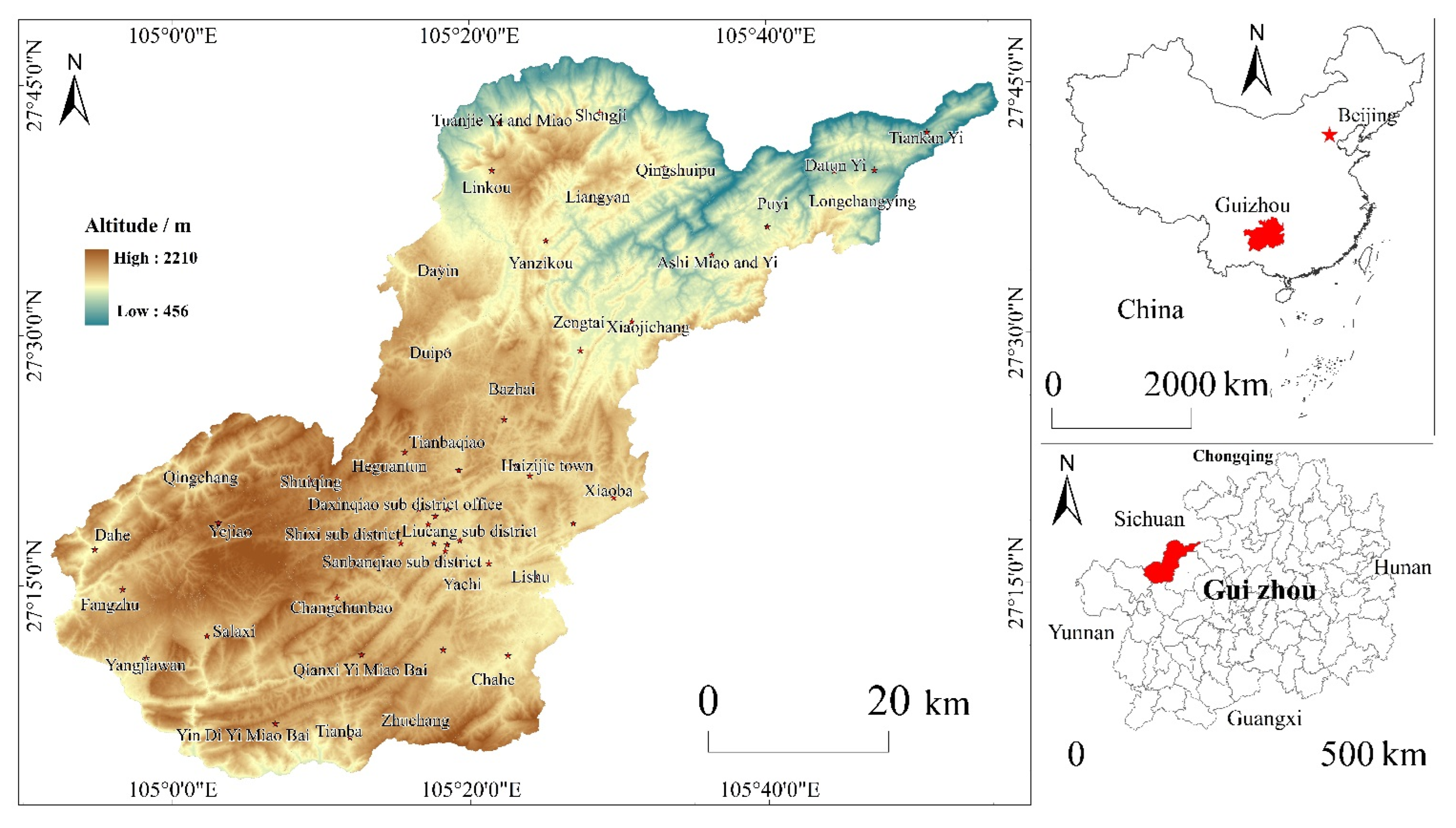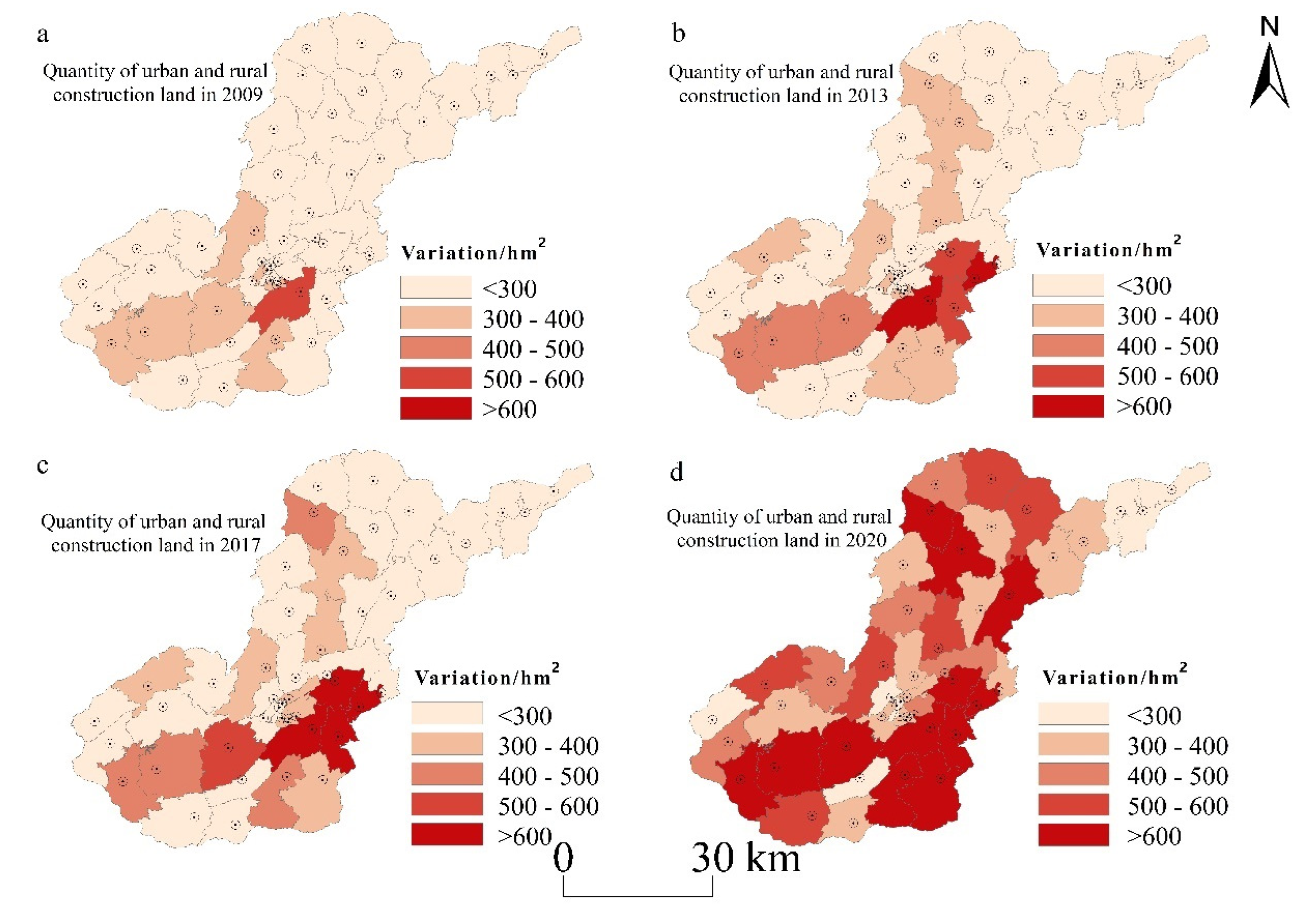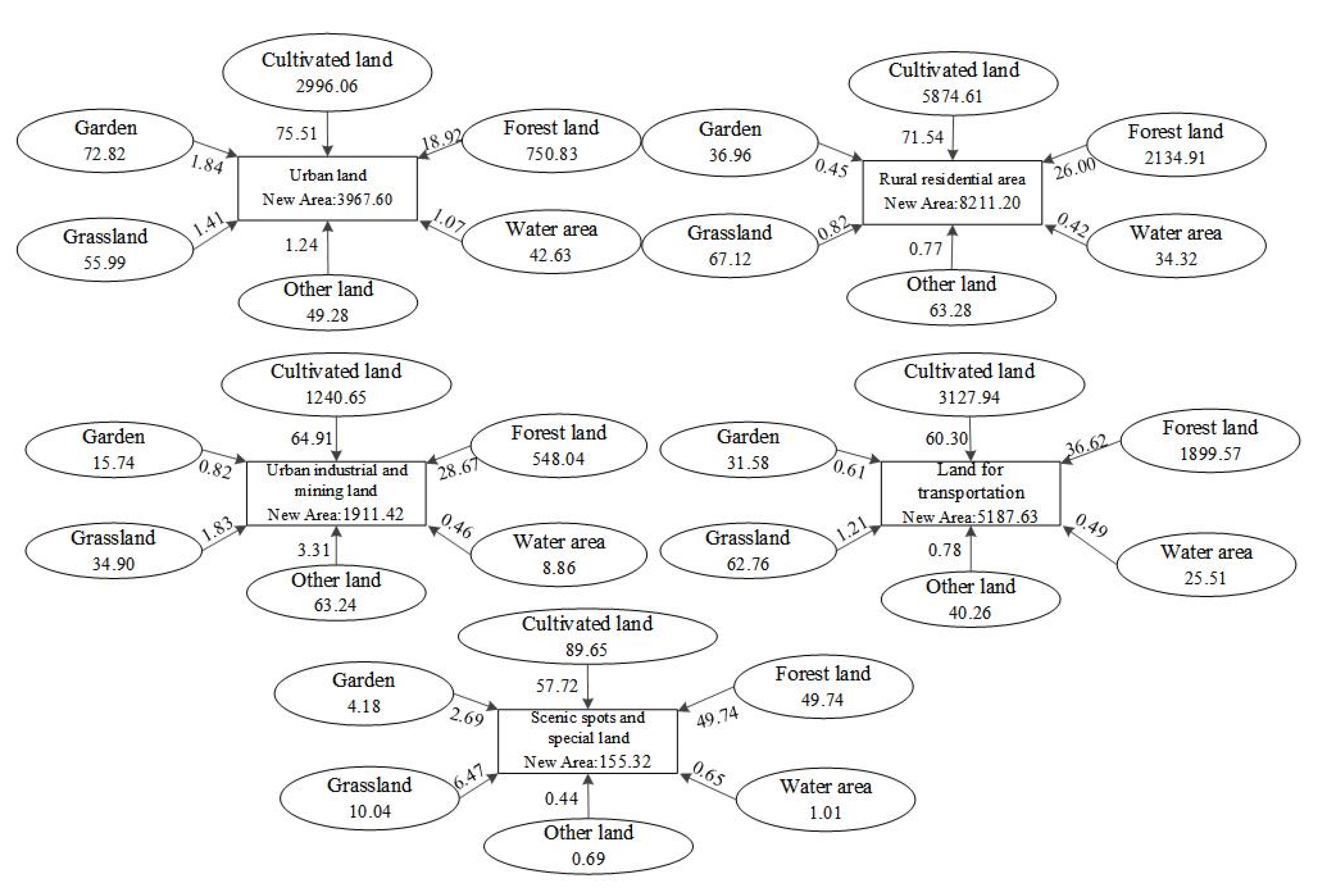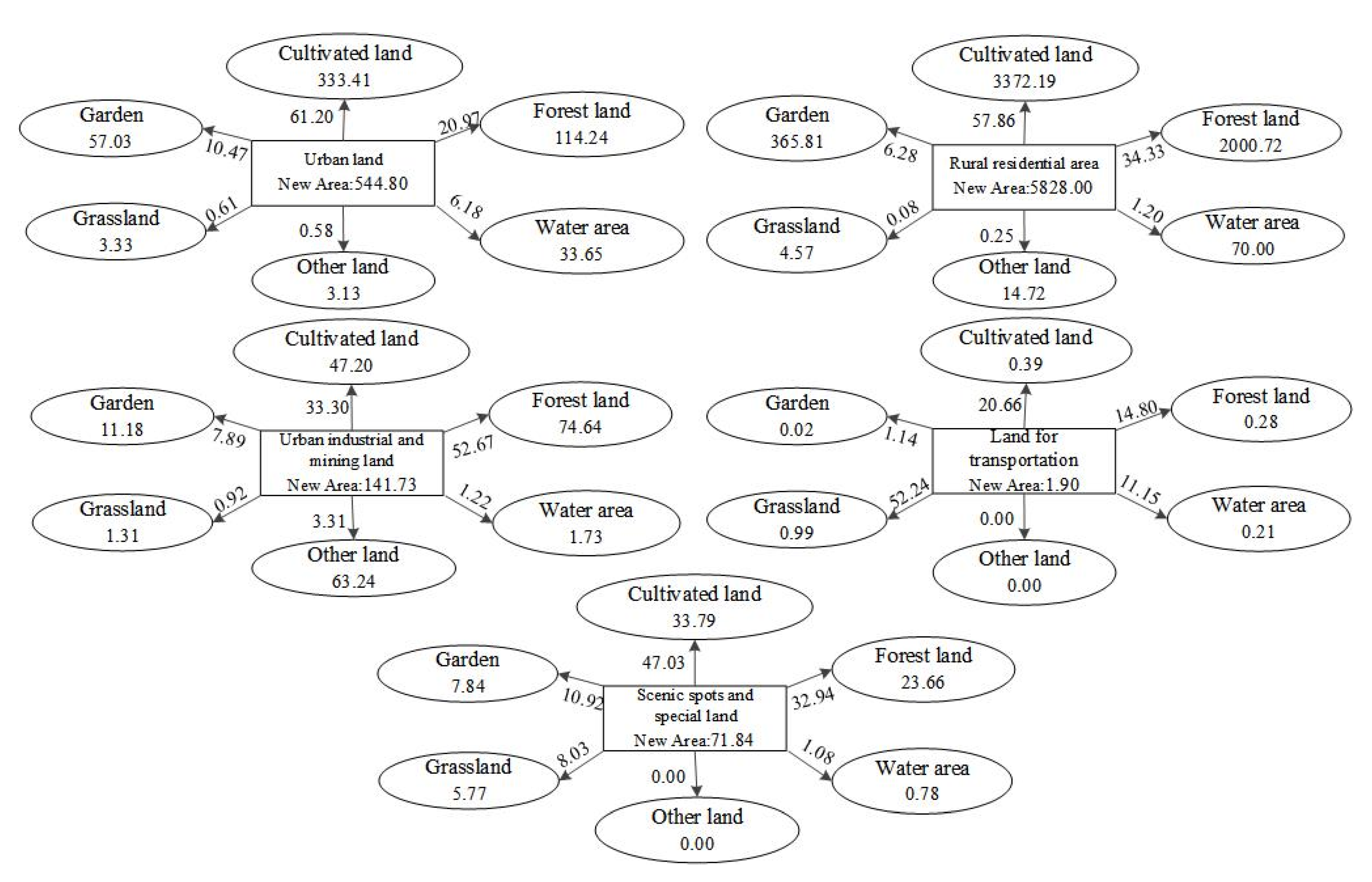The Spatial and Temporal Evolution Pattern and Transformation of Urban–Rural Construction Land in Karst Mountainous Areas: Qixingguan District of Guizhou, Southwest China
Abstract
:1. Introduction
2. Materials and Methods
2.1. Study Area
2.2. Data Resources
2.3. Analysis
2.3.1. GIS Spatial Analysis Method
2.3.2. Selection of Influencing Factors
2.3.3. Geographical Detector
3. Results and Discussion
3.1. Spatiotemporal Pattern Analysis of Urban–Rural Construction Land
3.1.1. Structure and Spatial Pattern of Urban–Rural Construction Land
3.1.2. Sources and Trends of Urban–Rural Construction Land
3.2. Analysis of Driving Factors of Urban–Rural Construction Land Transformation
3.2.1. Analysis of Detection Factor Influence
3.2.2. Interaction Analysis of Detection Factors
3.3. Discussion
3.3.1. Unreasonable Structure of Urban and Rural Construction Land
3.3.2. Transformation of Cultivated Land into Construction Land
3.3.3. Regular Evaluation of Planning and Dynamic Revision
3.3.4. Research Prospects
4. Conclusions
Author Contributions
Funding
Institutional Review Board Statement
Informed Consent Statement
Data Availability Statement
Acknowledgments
Conflicts of Interest
References
- Grainger, A. National land use morphology: Patterns and possibilities. Geography 1995, 80, 235–245. [Google Scholar]
- Ge, D.; Long, H.; Zhang, Y.; Ma, L.; Li, T. Farmland transition and its influences on grain production in China. Land Use Policy 2018, 70, 94–105. [Google Scholar] [CrossRef]
- Jiang, G.; Zhang, R.; Ma, W.; Zhou, D.; Wang, X.; He, X. Cultivated land productivity potential improvement in land consolidation schemes in Shenyang, China: Assessment and policy implications. Land Use Policy 2017, 68, 80–88. [Google Scholar] [CrossRef]
- Njoh, A.J. Municipal councils, international NGOs and citizen participation in public infrastructure development in rural settlements in Cameroon. Habitat Int. 2011, 35, 101–110. [Google Scholar] [CrossRef]
- Gu, C.; Li, Y.; Han, S.S. Development and transition of small towns in rural China. Habitat Int. 2015, 50, 110–119. [Google Scholar] [CrossRef]
- Li, T.; Long, H.; Liu, Y.; Tu, S. Multi-scale analysis of rural housing land transition under China’s rapid urbanization: The case of Bohai Rim. Habitat Int. 2015, 48, 227–238. [Google Scholar] [CrossRef]
- Song, X. Discussion on land use transition research framework. Acta Geogr. Sin. 2017, 72, 471–487, (In Chinese with English Abstract). [Google Scholar]
- Lambin, E.F.; Meyfroidt, P. Land use transitions: Socio-ecological feedback versus socio-economic change. Land Use Policy 2010, 27, 108–118. [Google Scholar] [CrossRef]
- Liu, Y.; Li, Y. Revitalize the world’s countryside. Nature 2017, 548, 275–277. [Google Scholar] [CrossRef] [Green Version]
- Tu, S.; Long, H. Rural restructuring in China: Theory, approaches and research prospect. J. Geogr. Sci. 2017, 27, 1169–1184, (In Chinese with English abstract). [Google Scholar] [CrossRef]
- Ventura, S.J.; Niemann, B.J.; Moyer, D.D. A multipurpose land information system for rural resource planning. J. Soil Water Conserv. 1988, 43, 226–229. [Google Scholar]
- Wasilewski, A.; Krukowski, K. Land conversion for suburban housing: A study of urbanization around Warsaw and Olsztyn, Poland. Environ. Manag. 2004, 34, 291–303. [Google Scholar] [CrossRef] [PubMed] [Green Version]
- Pijanowski, B.C.; Robinson, K.D. Rates and patterns of land use change in the Upper Great Lakes States, USA: A framework for spatial temporal analysis. Landsc. Urban Plan. 2011, 102, 102–116. [Google Scholar] [CrossRef]
- Livingstone, S.J.; Li, Y.; Rutishauser, A.; Sanderson, R.J.; Winter, K.; Mikucki, J.A.; Björnsson, H.; Bowling, J.S.; Chu, W.; Dow, C.F.; et al. Subglacial lakes and their changing role in a warming climate. Nat. Rev. Earth Environ. 2022, 3, 106–124. [Google Scholar] [CrossRef]
- Marsh, S. Plummeting morale in the forest service: Why it should matter to Americans who love nature. Mt. J. 2018, 20, 2020. [Google Scholar]
- Liu, M.; Bai, X.; Tan, Q.; Luo, G.; Zhao, C.; Wu, L.; Luo, X.; Ran, C.; Zhang, S. Climate Change Enhances the Positive Contribution of Human Activities to Vegetation restoration in China. Geocarto Int. 2022, 1–24. [Google Scholar] [CrossRef]
- Bourne, L.S. Reurbanization, uneven urban development, and the debate on new urban forms. Urban Geogr. 1996, 17, 690–713. [Google Scholar] [CrossRef]
- Jensen, J.R.; Toll, D.L. Detecting residential land-use development at the urban fringe. Photogramm. Eng. Remote Sens. 1982, 48, 629–643. [Google Scholar]
- López, E.; Bocco, G.; Mendoza, M.; Duhau, E. Predicting land-cover and land-use change in the urban fringe: A case in Morelia city, Mexico. Landsc. Urban Plan. 2001, 55, 271–285. [Google Scholar] [CrossRef]
- Braimoh, A.K.; Onishi, T. Spatial determinants of urban land use change in Lagos, Nigeria. Land Use Policy 2007, 24, 502–515. [Google Scholar] [CrossRef]
- Weber, C.; Puissant, A. Urbanization pressure and modeling of urban growth: Example of the Tunis Metropolitan Area. Remote Sens. Environ. 2003, 86, 341–352. [Google Scholar] [CrossRef]
- Masek, J.G.; Lindsay, F.E.; Goward, S.N. Dynamics of urban growth in the Washington DC metropolitan area, 1973–1996, from Landsat observations. Int. J. Remote Sens. 2000, 21, 3473–3486. [Google Scholar] [CrossRef]
- Saizen, I.; Mizuno, K.; Kobayashi, S. Effects of land-use master plans in the metropolitan fringe of Japan. Landsc. Urban Plan. 2006, 78, 411–421. [Google Scholar] [CrossRef]
- Ustaoglu, E.; Aydınoglu, A.C. Suitability evaluation of urban construction land in Pendik district of Istanbul, Turkey. Land Use Policy 2020, 99, 104783. [Google Scholar] [CrossRef]
- Mann, S. Institutional causes of urban and rural sprawl in Switzerland. Land Use Policy 2009, 26, 919–924. [Google Scholar] [CrossRef]
- Colsaet, A.; Laurans, Y.; Levrel, H. What drives land take and urban land expansion? A systematic review. Land Use Policy 2018, 79, 339–349. [Google Scholar] [CrossRef]
- Bittner, C.; Sofer, M. Land use changes in the rural-urban fringe: An Israeli case study. Land Use Policy 2013, 33, 11–19. [Google Scholar] [CrossRef]
- Diogo, V.; Koomen, E. Land-use change in Portugal, 1990–2006: Main processes and underlying factors. Cartogr. Int. J. Geogr. Inf. Geovis. 2012, 47, 237–249. [Google Scholar] [CrossRef]
- Duram, L.A. A pragmatic study of conventional and alternative farmers in Colorado. Prof. Geogr. 1997, 49, 202–213. [Google Scholar] [CrossRef]
- Luo, P.; Du, Q.; Lei, Y.; Wang, T. Cellular Automata Based on Geographic Feature and Urban Land Use Evolvement. Geomat. Inf. Sci. Wuhan Univ. 2004, 29, 504–507, (In Chinese with English Abstract). [Google Scholar]
- Thamodaran, R.; English, B.; Heady, E.O. A Statewide Projection of Agricultural Land Losses to Non-Agricultural Land Uses; Working Paper; Center for Agricultural and Rural Development, Iowa State University: Ames, IA, USA, 1981. [Google Scholar]
- Dewi, D.I.K.; Ratnasari, R.A. Land use change in sub district Mranggen because of residential development. Procedia-Soc. Behav. Sci. 2016, 227, 210–215. [Google Scholar] [CrossRef] [Green Version]
- Wang, J.F.; Li, X.H.; Christakos, G.; Liao, Y.L.; Zhang, T.; Gu, X.; Zheng, X.Y. Geographical detectors-based health risk assessment and its application in the neural tube defects study of the Heshun Region, China. Int. J. Geogr. Inf. Sci. 2010, 24, 107–127. [Google Scholar] [CrossRef]
- Bai, H.; Li, D.; Ge, Y.; Wang, J.; Cao, F. Spatial rough set-based geographical detectors for nominal target variables. Inf. Sci. 2022, 586, 525–539. [Google Scholar] [CrossRef]
- Wu, D.; Yang, L. Evaluation of Coordinated Development between Urbanization and Eco- environment in Wumeng Mountainous Areas of Guizhou—A Case Study of Qixingguan Region. Anhui Agric. Sci. Bull. 2016, 22, 97–102, (In Chinese with English Abstract). [Google Scholar]
- Zhou, D.B.; Huang, T.L.; Xiang, T.G.; Xie, G.; Huang, X.Y. Current Situation Analysis and Suggestions of Forest Ecological Industry in Qixingguan District of Bijie City. Mod. Agric. Sci. Technol. 2020, 759, 144–146, (In Chinese with English Abstract). [Google Scholar]
- Wang, X.H.; Zhang, Z.H.; Wang, H.B.; Xiao, B.; Liu, H.; Wang, T.; Wu, P.; Pan, Y.L. Geochemical Evaluation Results and significance of Cultivated Land Quality in Qixingguan District, Guizhou Province. Guizhou Geol. 2020, 37, 251–257, (In Chinese with English Abstract). [Google Scholar]
- GB/T 21010-2017; Current Land Use Classification. Standardization Administration of China: Beijing, China, 2017. (In Chinese)
- Zeng, Y.J. Coupling and Coordination between Urban-Rural Construction Land Transition and Economic and Social Development in Banan District Land Resource Management; Southwest University: Chongqing, China, 2019; (In Chinese with English Abstract). [Google Scholar]
- Unwin, D.J. GIS, spatial analysis and spatial statistics. Prog. Hum. Geogr. 1996, 20, 540–551. [Google Scholar] [CrossRef]
- Du, W.; Zhao, X.; Zhao, Z.; Chen, C.; Qian, D. Assessment and dynamic mechanisms of the land-use dominant morphology transition: A case study of Hainan Province, China. Environ. Monit. Assess. 2022, 194, 419. [Google Scholar] [CrossRef]
- Liu, F.; Qin, T.; Girma, A.; Wang, H.; Weng, B.; Yu, Z.; Wang, Z. Dynamics of land-use and vegetation change using NDVI and transfer matrix: A case study of the Huaihe River Basin. Pol. J. Environ. Stud. 2018, 28, 213–223. [Google Scholar] [CrossRef]
- Deng, X.; Huang, J.; Rozelle, S.; Uchida, E. Economic growth and the expansion of urban land in China. Urban Stud. 2010, 47, 813–843. [Google Scholar] [CrossRef] [Green Version]
- Wu, K.; Zhang, H. Land use dynamics, built-up land expansion patterns, and driving forces analysis of the fast-growing Hangzhou metropolitan area, eastern China (1978–2008). Appl. Geogr. 2012, 34, 137–145. [Google Scholar] [CrossRef]
- Wang, Y.; Wang, S.; Li, G.; Zhang, H.; Jin, L.; Su, Y.; Wu, K. Identifying the determinants of housing prices in China using spatial regression and the geographical detector technique. Appl. Geogr. 2017, 79, 26–36. [Google Scholar] [CrossRef]
- Wang, J.F.; Zhang, T.L.; Fu, B.J. A measure of spatial stratified heterogeneity. Ecol. Indic. 2016, 67, 250–256. [Google Scholar] [CrossRef]
- Ju, H.; Zhang, Z.; Zuo, L.; Wang, J.; Zhang, S.; Wang, X.; Zhao, X. Driving forces and their interactions of built-up land expansion based on the geographical detector–a case study of Beijing, China. Int. J. Geogr. Inf. Sci. 2016, 30, 2188–2207. [Google Scholar] [CrossRef]
- Wang, J.F.; Xu, C.D. Geodetector: Principle and prospective. J. Geogr. 2017, 72, 116–134, (In Chinese with English Abstract). [Google Scholar]
- Wu, Z.H.; Li, T. The comprehensive performance evaluation of the high-tech development zone: Analysis based on the natural breakpoint method. Stat. Inf. Forum 2013, 28, 82–88, (In Chinese with English Abstract). [Google Scholar]
- García-Ayllón, S. Predictive diagnosis of agricultural periurban areas based on territorial indicators: Comparative landscape trends of the so-called “Orchard of Europe”. Sustainability 2018, 10, 1820. [Google Scholar] [CrossRef] [Green Version]
- Li, Y.; Li, Y.; Westlund, H.; Liu, Y. Urban–rural transformation in relation to cultivated land conversion in China: Implications for optimizing land use and balanced regional development. Land Use Policy 2015, 47, 218–224. [Google Scholar] [CrossRef]
- Niu, X.; Liao, F.; Liu, Z.; Wu, G. Spatial-Temporal Characteristics and Driving Mechanisms of Land-Use Transition from the Perspective of Urban–Rural Transformation Development: A Case Study of the Yangtze River Delta. Land 2022, 11, 631. [Google Scholar] [CrossRef]
- García-Ayllón, S. Rapid development as a factor of imbalance in urban growth of cities in Latin America: A perspective based on territorial indicators. Habitat Int. 2016, 58, 127–142. [Google Scholar] [CrossRef]
- Hebbert, M. Urban sprawl and urban planning in Japan. Town Plan. Rev. 1986, 57, 141–158. [Google Scholar] [CrossRef]
- Alcock, I.; White, M.P.; Lovell, R.; Higgins, S.L.; Osborne, N.J.; Husk, K.; Wheeler, B.W. What accounts for ‘England’s green and pleasant land’? A panel data analysis of mental health and land cover types in rural England. Landsc. Urban Plan. 2015, 142, 38–46. [Google Scholar] [CrossRef] [Green Version]
- Newsome, W.B. French Urban Planning, 1940–1968: The Construction and Deconstruction of an Authoritarian System; Peter Lang: Bern, Switzerland, 2009. [Google Scholar]
- Zhang, T. Community features and urban sprawl: The case of the Chicago metropolitan region. Land Use Policy 2001, 18, 221–232. [Google Scholar] [CrossRef]
- Schumacher, M.; Durán-Díaz, P.; Kurjenoja, A.K.; Gutiérrez-Juárez, E.; González-Rivas, D.A. Evolution and Collapse of Ejidos in Mexico—To What Extent Is Communal Land Used for Urban Development? Land 2019, 8, 146. [Google Scholar] [CrossRef] [Green Version]
- Chen, F.; Bai, X.; Liu, F.; Luo, G.; Tian, Y.; Qin, L.; Li, Y.; Xu, Y.; Wang, J.; Wu, L.; et al. Analysis Long-Term and Spatial Changes of Forest Cover in Typical Karst Areas of China. Land 2022, 11, 1349. [Google Scholar] [CrossRef]
- Song, F.; Wang, S.; Bai, X.; Wu, L.; Wang, J.; Li, C.; Chen, H.; Luo, X.; Xi, H.; Zhang, S.; et al. A new indicator for global food security assessment: Harvested area rather than cropland area. Chin. Geogr. Sci. 2022, 32, 204–217. [Google Scholar] [CrossRef]
- Wu, L.; Wang, S.; Bai, X.; Chen, F.; Li, C.; Ran, C.; Zhang, S. Identifying the Multi-Scale Influences of Climate Factors on Runoff Changes in a Typical Karst Watershed Using Wavelet Analysis. Land 2022, 11, 1284. [Google Scholar] [CrossRef]
- Du, C.; Bai, X.; Li, Y.; Tan, Q.; Zhao, C.; Luo, G.; Wu, L.; Chen, F.; Li, C.; Ran, C.; et al. Inventory of China’s Net Biome Productivity since the 21st Century. Land 2022, 11, 1244. [Google Scholar] [CrossRef]
- Xiong, L.; Bai, X.; Zhao, C.; Li, Y.; Tan, Q.; Luo, G.; Wu, L.; Chen, F.; Li, C.; Ran, C.; et al. High-Resolution Data Sets for Global Carbonate and Silicate Rock Weathering Carbon Sinks and Their Change Trends. Earth’s Future 2022, 10, e2022EF002746. [Google Scholar] [CrossRef]
- Hu, S.; Zhang, Y.; Yang, Z.; Yan, D.; Jiang, Y. Challenges and opportunities for carbon neutrality in China’s building sector—Modelling and data. Build. Simul. 2022, 15, 1899–1921. [Google Scholar] [CrossRef]
- Li, C.; Bai, X.; Tan, Q.; Luo, G.; Wu, L.; Chen, F.; Xi, H.; Luo, X.; Ran, C.; Chen, H.; et al. High-resolution mapping of the global silicate weathering carbon sink and its long-term changes. Glob. Chang. Biol. 2022, 28, 4377–4394. [Google Scholar] [CrossRef] [PubMed]
- Zhang, S.; Bai, X.; Zhao, C.; Tan, Q.; Luo, G.; Wu, L.; Xi, H.; Li, C.; Chen, F.; Ran, C.; et al. China’s carbon budget inventory from 1997 to 2017 and its challenges to achieving carbon neutral strategies. J. Clean. Prod. 2022, 347, 130966. [Google Scholar] [CrossRef]





| Influencing Factor | Number | Detection Factor | Access | Definition of Indicator |
|---|---|---|---|---|
| Basic natural conditions | X10 | Terrain slope | Based on DEM, obtained using ArcGIS slope calculation tool | Basis of natural conditions |
| X11 | Average elevation | Based on DEM data, using ArcGIS software partition statistics | Basis of natural conditions | |
| X12 | Road network density | Total road area/total area | Degree of traffic development | |
| Level of economic development | X1 | GDP per capita | Total GDP/total population of region | Level of economic development |
| X2 | Average GDP | Total GDP/total area of region | Level of economic development | |
| X9 | Gross industrial output | Bijie Seven Star Customs District Statistical Yearbook | Level of industrial development | |
| X7 | Total fiscal revenue | Outline of National Economic and Social Development Plan | Level of economic strength | |
| X7 | Completed investment in fixed assets of whole society | Total investment in social fixed assets/area of urban and rural construction land | Land use investment intensity | |
| Social life conditions | X3 | Urbanization rate | Urban permanent population/total regional population | Population agglomeration level |
| X4 | Population density | Total population of region/total area of region | Population agglomeration level | |
| X5 | Population density | Directly obtained from Bijie Qixingguan District Statistical Yearbook | Population agglomeration level | |
| X8 | Total salary of employees of unit at end of year | Directly obtained from Bijie Qixingguan District Statistical Yearbook | Social life conditions |
| Classification of Land Use | Statistical Indicator | 2009 | 2013 | 2017 | 2020 |
|---|---|---|---|---|---|
| Urban land | Number of polygons | 606 | 1060 | 2570 | 8155 |
| Area | 2193.14 | 3234.55 | 4177.09 | 5587.29 | |
| Proportion | 21.85 | 25.34 | 28.86 | 24.42 | |
| Rural residential land | Number of polygons | 22,648 | 22,863 | 24,382 | 75,178 |
| Area | 7536.82 | 7614.13 | 7793.91 | 9552.45 | |
| Proportion | 75.11 | 59.65 | 53.85 | 41.75 | |
| Urban industrial and mining land | Number of polygons | 436 | 655 | 679 | 1974 |
| area | 195.82 | 668.46 | 671.82 | 2086.95 | |
| proportion | 1.95 | 5.24 | 4.64 | 9.12 | |
| Traffic land | Number of polygons | 6 | 740 | 1569 | 18,251 |
| Area | 7.53 | 1144.65 | 1721.40 | 5467.53 | |
| Proportion | 0.08 | 8.97 | 11.89 | 23.90 | |
| Scenic spots and special land | Number of polygons | 256 | 256 | 262 | 888 |
| Area | 101.66 | 103.83 | 108.36 | 185.64 | |
| Proportion | 1.01 | 0.81 | 0.75 | 0.81 | |
| Aggregate statistics | Total area | 10,034.97 | 12,765.62 | 14,472.59 | 22,879.86 |
| Detection Factor | X1 | X2 | X3 | X4 | X5 | X6 | X7 | X8 | X9 | X10 | X11 | X12 |
|---|---|---|---|---|---|---|---|---|---|---|---|---|
| PD value | 0.325 | 0.291 | 0.328 | 0.189 | 0.351 | 0.205 | 0.819 | 0.304 | 0.607 | 0.139 | 0.134 | 0.440 |
| p value | 0.073 | 0.414 | 0.251 | 0.553 | 0.096 | 0.434 | 0.000 | 0.148 | 0.000 | 0.386 | 0.566 | 0.193 |
| X1 | X2 | X3 | X4 | X5 | X6 | X7 | X8 | X9 | X10 | X11 | X12 | |
|---|---|---|---|---|---|---|---|---|---|---|---|---|
| X1 | 0.303 | |||||||||||
| X2 | 0.870 | 0.185 | ||||||||||
| X3 | 0.868 | 0.840 | 0.474 | |||||||||
| X4 | 0.863 | 0.840 | 0.591 | 0.339 | ||||||||
| X5 | 0.342 | 0.903 | 0.891 | 0.892 | 0.302 | |||||||
| X6 | 0.868 | 0.814 | 0.642 | 0.410 | 0.891 | 0.268 | ||||||
| X7 | 0.947 | 0.941 | 0.882 | 0.937 | 0.957 | 0.936 | 0.860 | |||||
| X8 | 0.868 | 0.817 | 0.542 | 0.646 | 0.896 | 0.557 | 0.878 | 0.386 | ||||
| X9 | 0.753 | 0.906 | 0.915 | 0.912 | 0.751 | 0.970 | 0.931 | 0.925 | 0.540 | |||
| X10 | 0.717 | 0.720 | 0.707 | 0.513 | 0.724 | 0.514 | 0.902 | 0.538 | 0.721 | 0.120 | ||
| X11 | 0.338 | 0.482 | 0.544 | 0.491 | 0.360 | 0.484 | 0.881 | 0.599 | 0.623 | 0.273 | 0.099 | |
| X12 | 0.819 | 0.529 | 0.794 | 0.851 | 0.848 | 0.829 | 0.916 | 0.764 | 0.913 | 0.625 | 0.676 | 0.225 |
Publisher’s Note: MDPI stays neutral with regard to jurisdictional claims in published maps and institutional affiliations. |
© 2022 by the authors. Licensee MDPI, Basel, Switzerland. This article is an open access article distributed under the terms and conditions of the Creative Commons Attribution (CC BY) license (https://creativecommons.org/licenses/by/4.0/).
Share and Cite
Sun, Y.; Zhou, Z.; Huang, D.; Chen, Q.; Fang, M. The Spatial and Temporal Evolution Pattern and Transformation of Urban–Rural Construction Land in Karst Mountainous Areas: Qixingguan District of Guizhou, Southwest China. Land 2022, 11, 1734. https://doi.org/10.3390/land11101734
Sun Y, Zhou Z, Huang D, Chen Q, Fang M. The Spatial and Temporal Evolution Pattern and Transformation of Urban–Rural Construction Land in Karst Mountainous Areas: Qixingguan District of Guizhou, Southwest China. Land. 2022; 11(10):1734. https://doi.org/10.3390/land11101734
Chicago/Turabian StyleSun, Yaopeng, Zhongfa Zhou, Denghong Huang, Quan Chen, and Min Fang. 2022. "The Spatial and Temporal Evolution Pattern and Transformation of Urban–Rural Construction Land in Karst Mountainous Areas: Qixingguan District of Guizhou, Southwest China" Land 11, no. 10: 1734. https://doi.org/10.3390/land11101734





